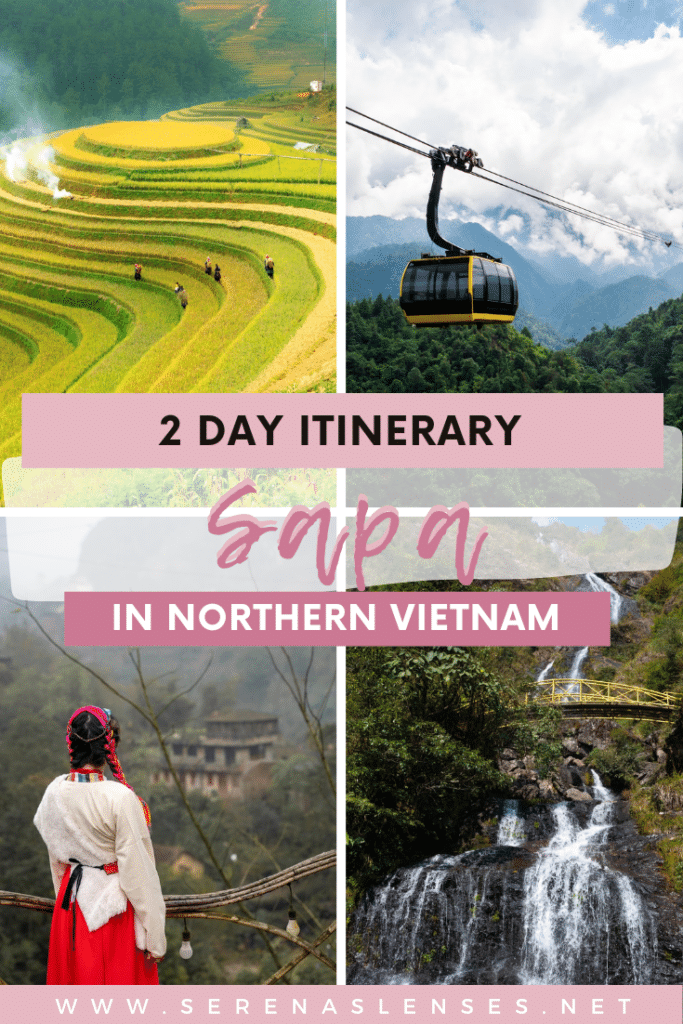2 Day Sapa Itinerary: Best Things to do in Sapa in 48 Hours
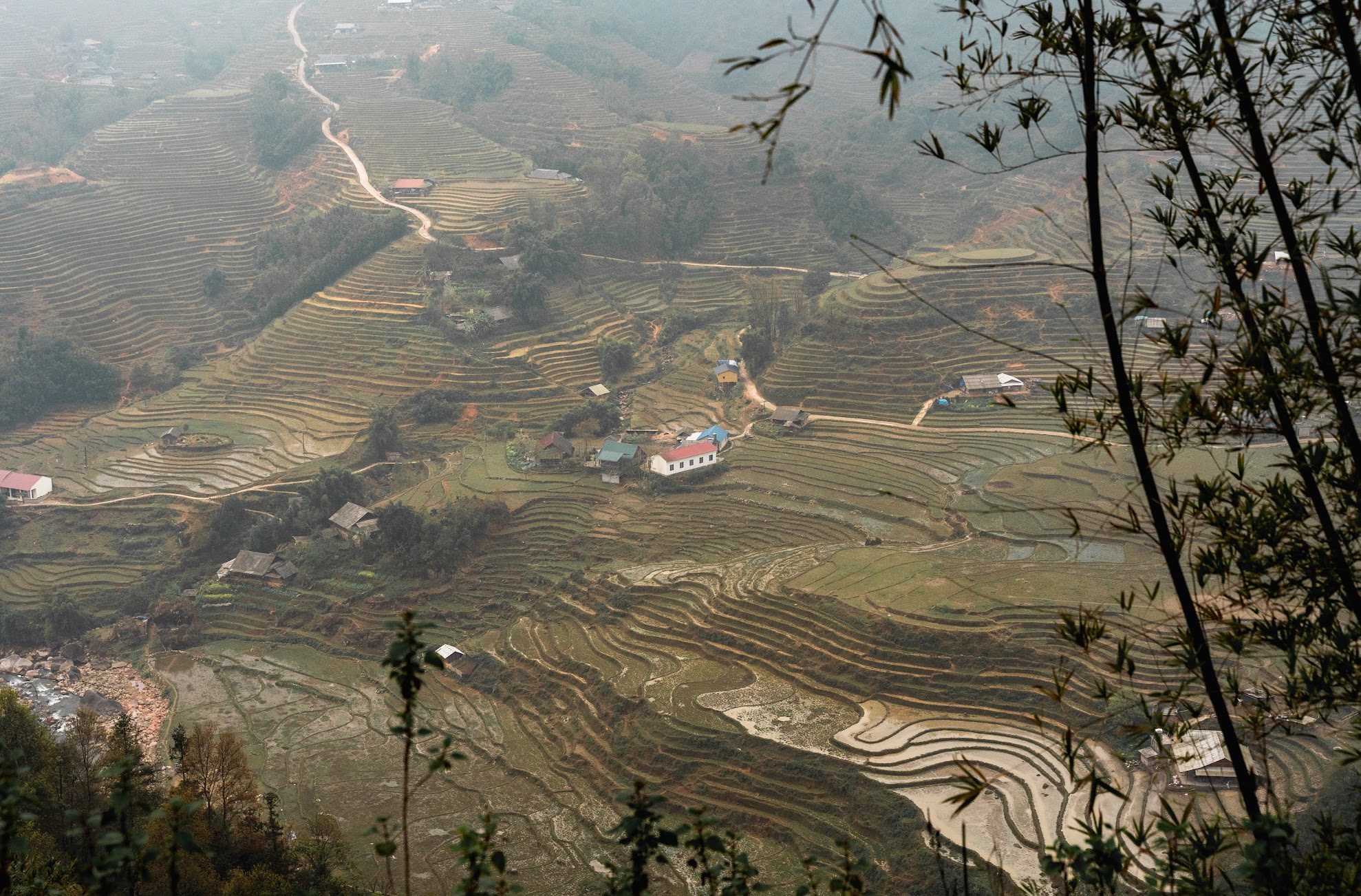
Wondering what are the best things to do for 2 days in Sapa? This Sapa itinerary and travel guide shows you what to do, how to get to Sapa, how to get around, where to stay and eat.
Nestled amidst the mist-kissed mountains of northern Vietnam, Sapa is a popular tourist destination for those looking for nature and adventure.
When you think of Sapa, rolling hills with rice fields probably comes to mind. While Sapa is famous for its beautiful rice terraces, there are so much more to Sapa than that.
From trekking to hiking to waterfalls to exploring local villages to relaxing in outdoor pools, Sapa is a dreamy destination for you regardless of what type of traveler you are.
Wondering how to best spend 2 days in Sapa to see all its glory? This Sapa itinerary tells you the best things to do and places to go in Sapa. This Sapa travel guide also gives you practical travel information, such as how to get there, where to stay, how to get around and what to eat.
Planning a trip to Vietnam?
I love traveling to Vietnam and have written a TON of Vietnam travel guides.
From Halong Bay to Hue to Hoi An, I have all the information to help you plan your Vietnam itinerary.
Whether you are planning to spend 10 days or 2 weeks in Vietnam, you will definitely find these articles helpful.
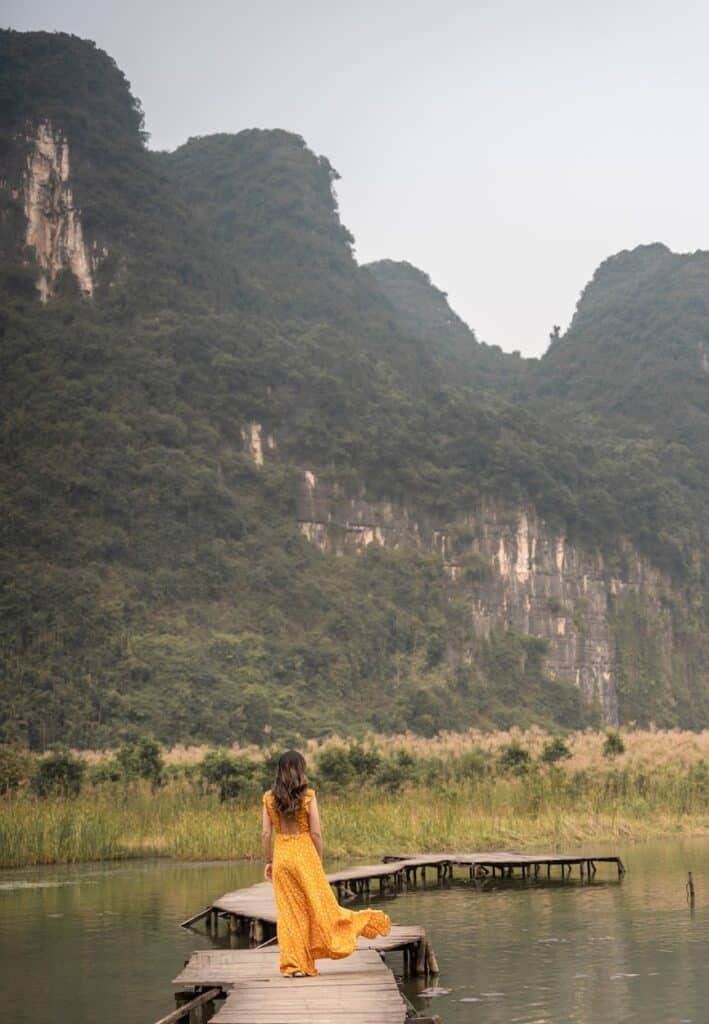
This blog contains occasional affiliate links, where I receive a small commission on sales of the products/hotels that are linked at no additional cost to you. In addition, as an Amazon Associate, I earn from qualifying purchases.
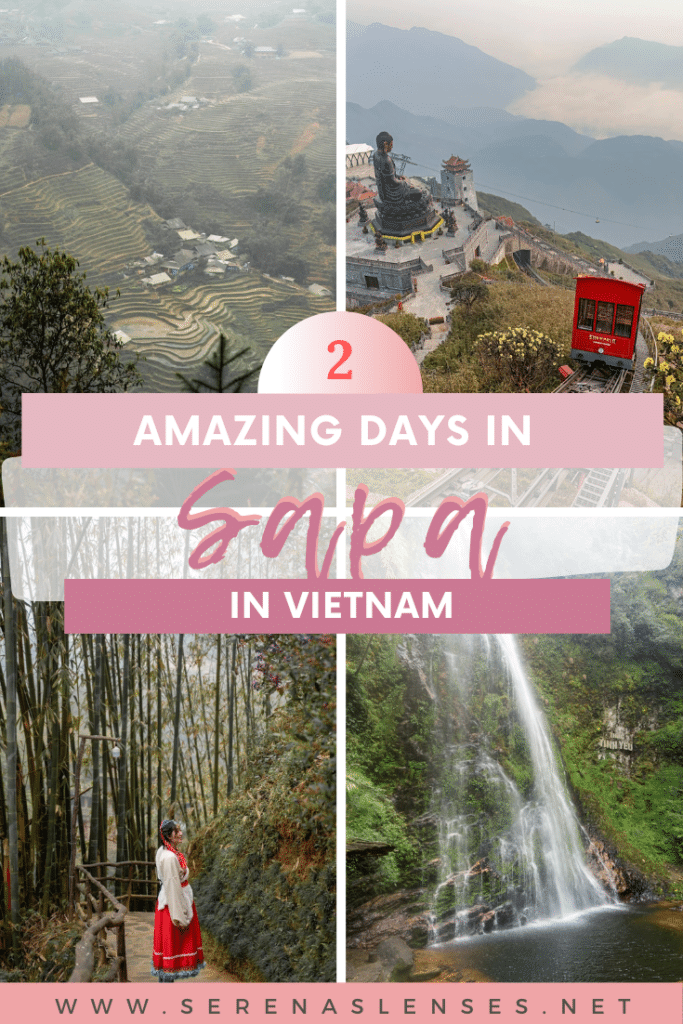
Where is Sapa?
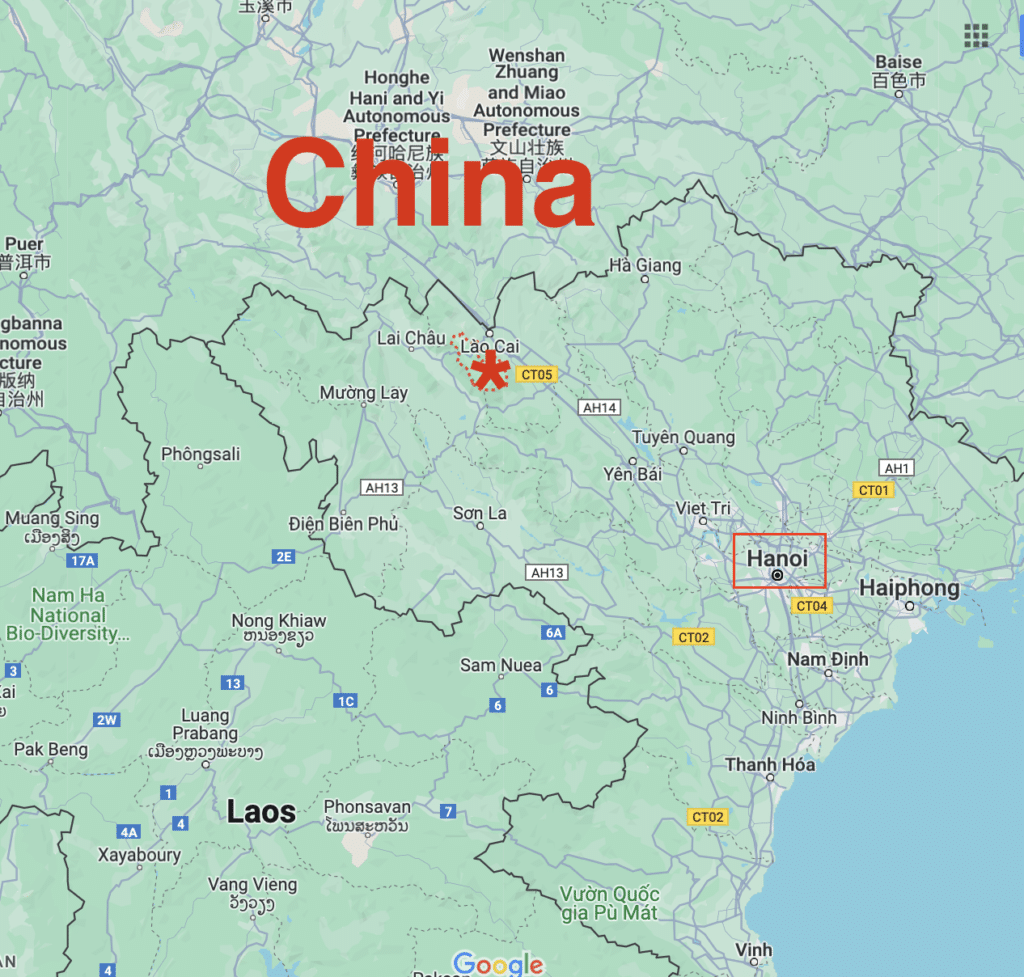
Sapa is located in Northern Vietnam near the border of China. The closest city to Sapa is Lao Cai, about 186 miles (300 kilometers) northwest of Hanoi, the capital city of Vietnam.
Sapa town is nestled in the Hoàng Liên Son mountain range, known for its picturesque landscapes, terraced rice fields, and its ethnic communities, with the Hmong people as the largest ethnic group in Sapa.
Since it is in the mountains, it has an altitude of about 4900 feet (1500 meters). I don’t think this altitude is enough to give you altitude sickness or anything like that but it is colder and foggier than places like Hanoi.
How to Get to Sapa
There is no airport in Sapa; the closest airport to Sapa is Hanoi’s Noi Bai International Airport in Hanoi.
To get to Sapa from Hanoi, there are different things you can do: overnight train, overnight bus, shared van or private driver.
Overnight train from Hanoi to Sapa
In my opinion, the overnight train from Hanoi to Sapa is the safest way to get to Sapa, albeit not the most comfortable.
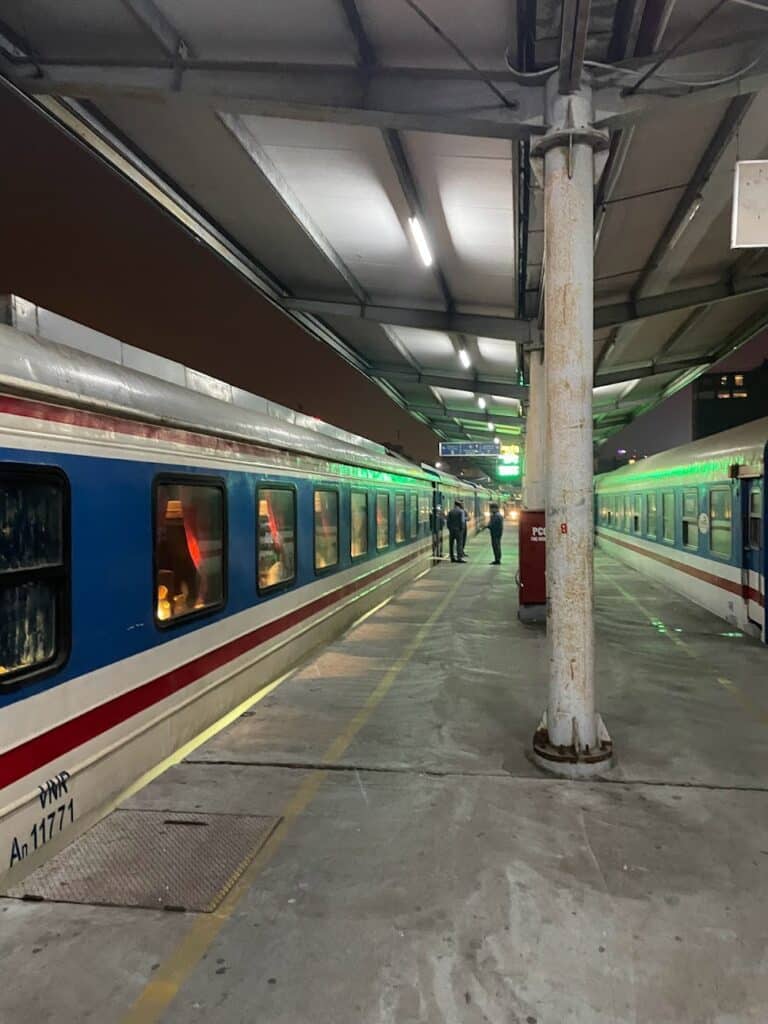
The train from Hanoi to Sapa takes 8 hours and they are almost all overnight sleeper trains. There are different companies when you try to book the train but they all ultimately run on the same line at the same time.
Essentially Vietnam Railways operates the train and each company can attach their own car to the Reunification Express Train. So if you book a luxury Sapa train, that just means you are staying in a more luxury car.
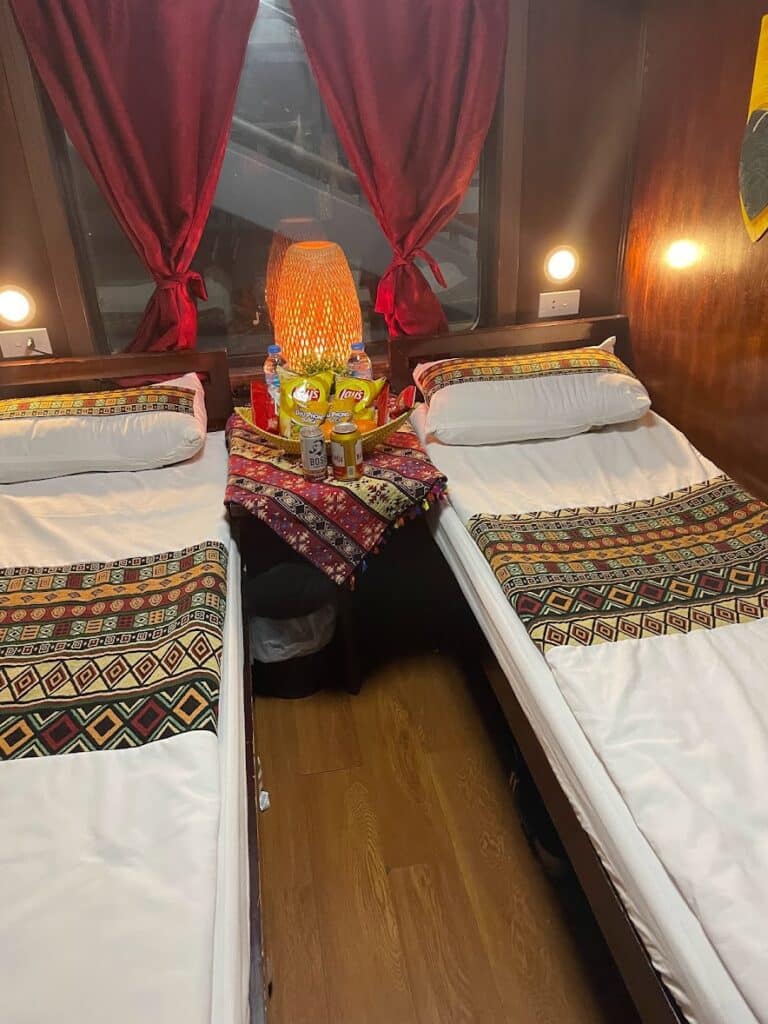

I took the overnight train from Hanoi to Sapa and you can read more about my experience. The best and most reliable website to book Vietnam sleeper train tickets is 12go (You need to search Hanoi to Lao Cai, not to Sapa or it will only show you bus options).
The sleeper train from Hanoi to Sapa costs between USD 20 to USD 70, depending on the train, class, and room type (the less people in the room the more expensive it is).
After you get off the train at Lao Cai, you will need a separate transfer (usually a shared van) to Sapa town. We pre-arranged this with our trekking company, and it cost an extra $4 USD a person. The ride to Sapa from Lao Cai train station was about another hour.
Bus from Hanoi to Sapa
Another popular way to travel between Hanoi and Sapa is to take a sleeper bus, either during the day or at night (yes you can take a sleeper bus during the day).
The bus ride between Hanoi and Sapa takes about 5.5 – 6 hours, depending on traffic conditions.
There are different types of buses, some are actual sleeper buses whereas others are buses with reclining seats. Of course with different types of buses comes different prices. Generally buses from Hanoi to Sapa cost between $10 to $25 USD per person, a lot cheaper than trains.
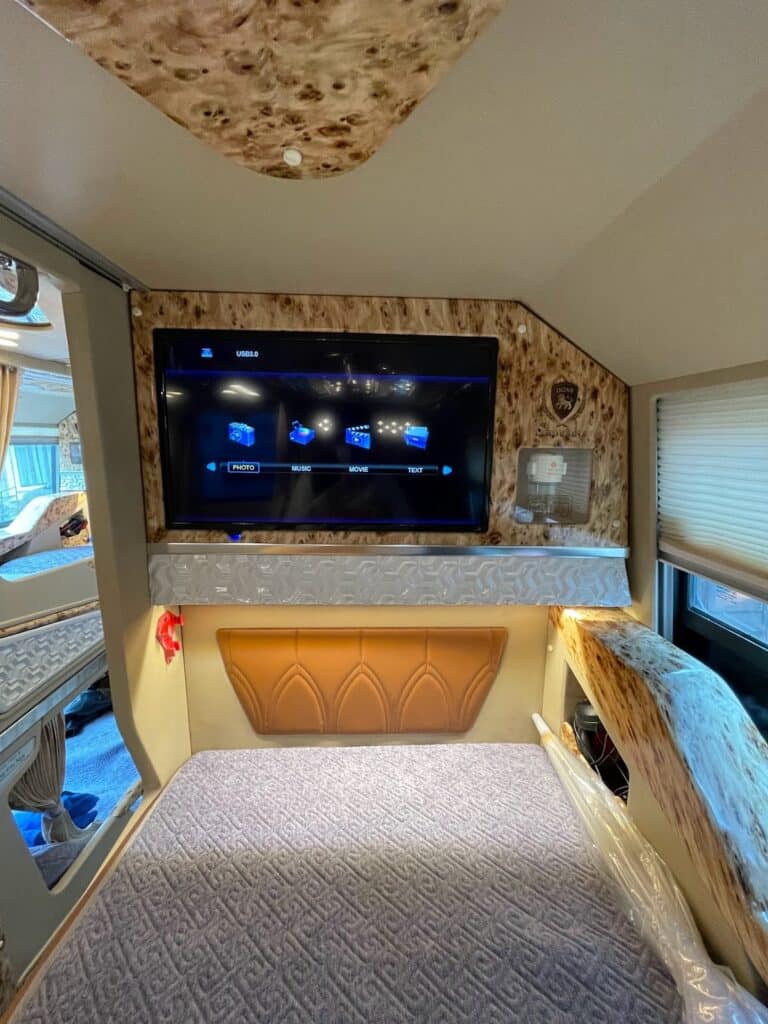
We took a luxury “cabin” bus back to Hanoi from Sapa after our 2 days in Sapa. The cabin bus was the most expensive option and the most comfortable in terms of all buses. The cabin buses are not your average sleeper bus, it actually was really nice with a private “cabin”, screen, USB charging and water.
The bus ride was way more comfortable than the sleeper train, but Vietnam drivers have pretty intense driving habits and I would be a bit hesitant to take a sleeper bus at night (we took it during the day).
Again, you can book your Hanoi to Sapa bus on 12go.
Private Transfer from Hanoi to Sapa
There are a ton of private transfers you can book, ranging from luxury shared van to actual private car. You can expect a private car to be the most expensive way to get to Sapa and it is best to reserve those in advance.
We took shared vans around Vietnam and they were quite nice, with USB charging and everything. Unless you have 3-4 people, I think a shared van would be good enough for your trip.
You can book a shared van or a private car on 12go or book this shared van.
General Travel Information for Sapa
Currency: You need to have Vietnamese Dong in Sapa (they do not accept USD!!).
Cash is king: Definitely bring cash with you as most places in Sapa do not take credit card (except hotels and specific restaurants).
There are ATMs in Sapa: We found ATMs in Sapa, and that is the best way to take out cash. Exchanging money in Vietnam would give you a much worse rate than ATMs. If you are American, I recommend you get the Charles Schwab ATM card which reimburses you ATM fees worldwide.
Sapa is cold: It is located in the mountains and it is further north, so temperatures are much lower than in Hanoi. Bring layers and jackets with you to Sapa, you won’t regret it.
Do not drink the tap water: as in other parts of Vietnam and Southeast Asia, you cannot drink tap water. Try to avoid ice in your drinks as well to avoid food poisoning.
Sapa is expensive: I actually found Sapa more expensive than all the other areas we visited in Vietnam. It is touristy for sure and prices are quite high, so be prepared.
Download Whatsapp! Businesses are done over Whatsapp (like bus/ train booking, hotel communication etc). It is so much easier to communicate over Whatsapp than email.
You need the internet in Sapa. I assume you would already have a sim card if you came from Hanoi, but if not, I highly recommend getting an eSIM in Vietnam. I had one and it worked brilliantly.
Sapa is hilly. If you have mobility issues, Sapa would not be a good place for you. The city is hilly and I saw a lot of stairs in the town just trying to get to our hotel.
Best (and Worst) time to Visit Sapa
You may (or may not) have heard that the best time to visit Vietnam is between November and April, with comfortable weather during the dry season.
Well, Sapa is not like anywhere else in Vietnam. Since it is north and located in the mountains, and I assume you are going to Sapa for the rice terraces and (maybe) trekking, you should definitely read this part carefully.

Rice harvesting time in Sapa is between late August to early October. This is when the rice paddies are at their prettiest and turn gold for harvesting. Even though it is still technically during the rainy season, these two months are the prettiest months to visit Sapa.
After harvesting, the rice fields will be empty, all you will see is some muddy and brownish color of the rice fields.
April and May is a good time to visit if you want to enjoy warmer (but not too hot) weather and less rain. You can also see wildflowers during this time but the rice paddies are not going to be lush green yet.
Our Sapa trekking guide told us that July and August are great times to visit Sapa despite the rain because the days will be clear (after the rain) and rice terraces will be green. It is apparently peak domestic tourist season and it can get quite hot and humid, but if a local recommends that time frame, I believe it.
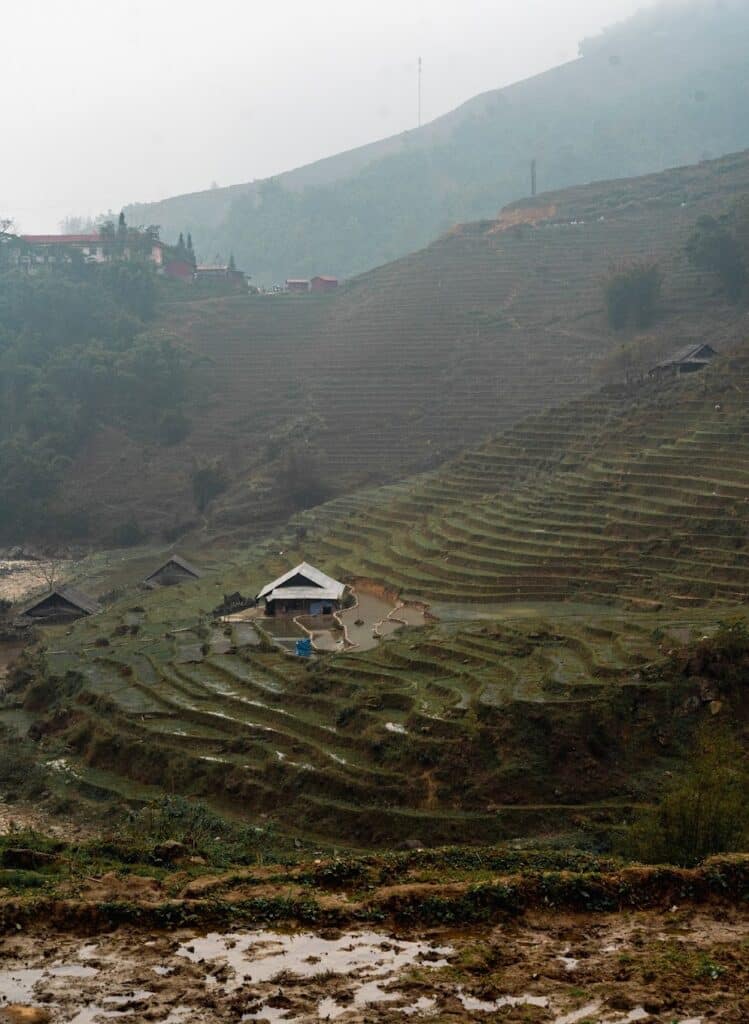
I visited early March, and let’s just say that I would not recommend visiting Sapa during the winter month. The weather was cold especially in the morning and at night but that didn’t bother us (given that we came from New York City and February is absolutely freezing). What bothered us was the lack of visibility.
The fog in Sapa when we visited was so bad I literally saw nothing 90% of the time I was there. Our trekking guide said the day before we arrived Sapa was perfectly clear, but most of the time it is foggy in the winter even if it doesn’t rain.
Therefore, I would say November to March is probably the worst time to go to Sapa because most likely you won’t see anything at all. Even if you do see something, the rice terraces are not green or gold.
In conclusion, you could be unlucky and encounter heavy rain and fog regardless of when you visit or you could get lucky and get a perfectly clear day even when you visit in the winter. Weather in Sapa is unpredictable since it’s in the mountains and all the weather forecast services/ apps are not accurate (it showed it was sunny when we were there when it clearly was not sunny).
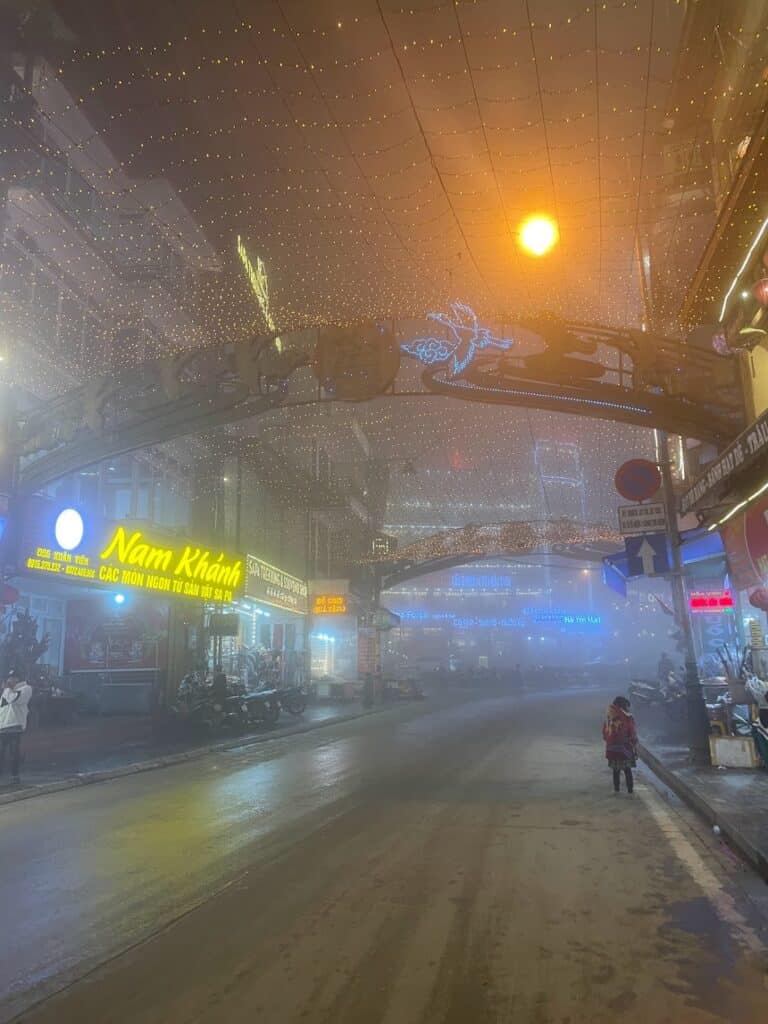
Where to Stay in Sapa
There is a wide range of accommodations in Sapa, either in the town itself, a few minutes from the town, or in homestays in the different villages.
I looked into a number of hotels when I was planning this Sapa trip because I really wanted a hotel with good reviews and an amazing view.
We ended up staying at Pistachio Hotel in the middle of town because of its infinity pool against the mountainous backdrop (spoiler alert: we saw no views because of the fog), but on a clear day it should look like this below.
The other two hotels that I HIGHLY considered were Topas Ecolodge and Laxsik Ecolodge. Both have amazing reviews and a beautiful infinity pool with the rice terrace in the background (and you get your own lodge). We ended up picking the Pistachio hotel because it was cheaper and loated in the center of town.
How Long Do You Need in Sapa
You need at least two days in Sapa to experience Sapa, do a trek and visit some of the surrounding villages and famous attractions.
If you have a lot of time and love trekking and outdoor activities, I would highly recommend spending 4 to 5 days in Sapa to fully explore this town and the surrounding area.
We spent 2 days in Sapa and wish we could have spent one more day there. Also with the unpredictable weather it is always better to have more days there.
What to do in Sapa for 2 Days
We spent two days in Sapa and it was a very eventful 2 days. This detailed 2 day Sapa itinerary can be customized to fit your own need and interest since I will give you some options you can include!
Day 1 in Sapa: Arrival + Trekking
Morning: arriving in Sapa
If you are taking an overnight train or bus to Sapa, you will arrive in Sapa early in the morning (~6 am). I hope you rested well on your way to Sapa as this will be a long first day!
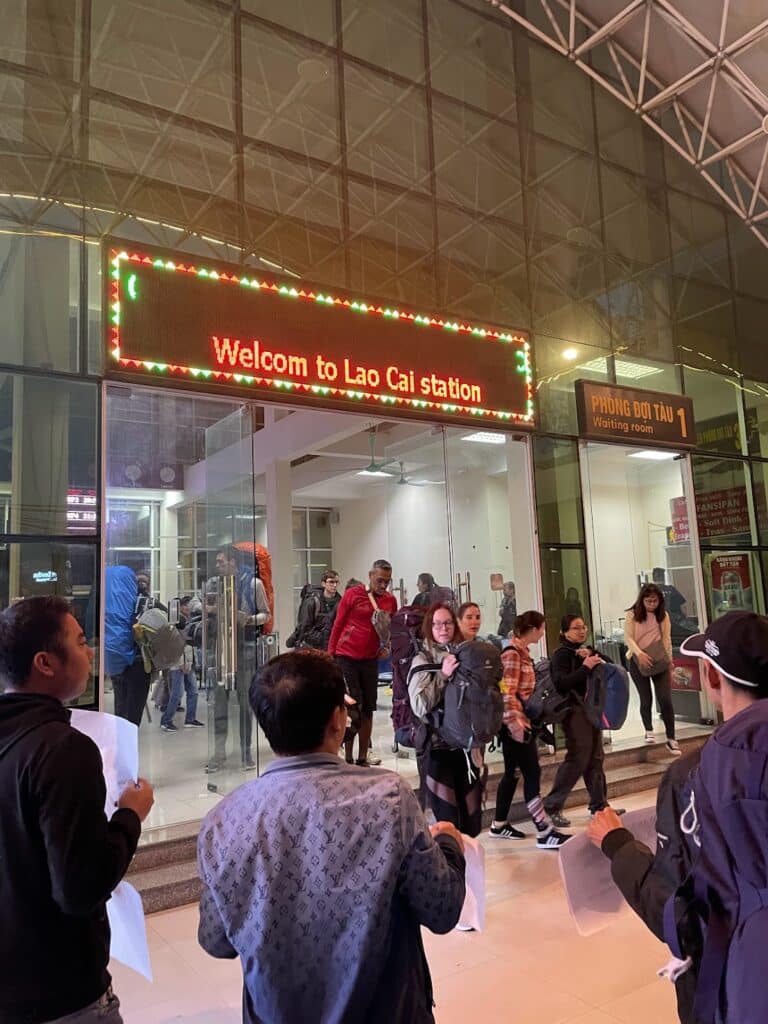

9am to 3pm: Trekking or Motorcycle Tour
Sapa is famous for trekking so you simply cannot miss this experience! There are many different trekking companies and tour options in Sapa that can get a bit overwhelming. Given you only have two days in Sapa, you can only do the one day trek to see a couple of villages before heading back to Sapa town in the afternoon.
We booked the one day trek with Sapa Sisters because of their raving reviews and it cost us $39 USD per person for a private guide. There are cheaper Sapa trekking tours like this one that group you with other people.
If you do have more than 2 days in Sapa (or you only want to trek), then the 2 day 1 night trek would be perfect. The overnight stay would be at a local homestay so you can get an authentic and unique experience.
I read that you do not actually have to pre-book trekking as there will be many people asking if you want to trek once you get to Sapa.
However with our luggage and backpacks I am glad we pre-booked since we were able to drop our things off at Sapa Sisters’ office, take a break, before meeting our private guide, a nice Hmong woman who brought her baby with her!
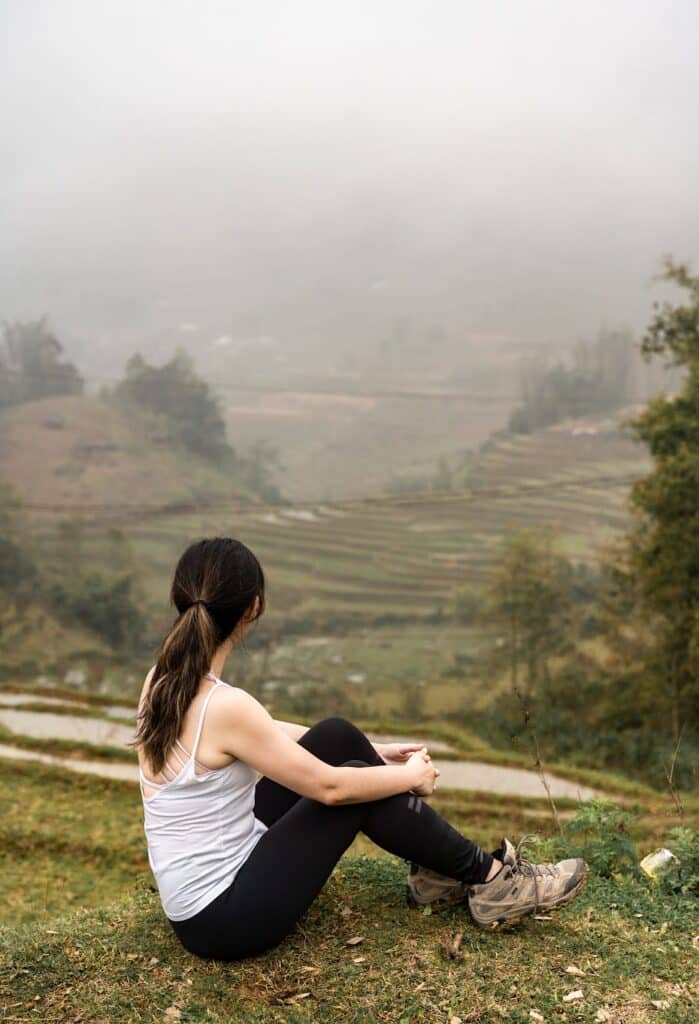

If you have a private guide, you can customize how easy or how difficult you want the trek to be. We opted for an easy one and went to a few villages including the village where our guide was from.


In general the guide will take you to some viewpoints, walk by the villages, grab lunch, and finish the day in the last village before a bus takes you back to Sapa town.
If you do not want to trek but you feel comfortable riding a motorbike, then I would recommend this motorbike tour as an alternative to see the landscape of Sapa and visit some of the ethnic villages.
Late afternoon & Evening
You will be back in Sapa around 3pm after trekking. Our trekking tour took us back to the Sapa Sisters trekking office, where we washed our shoes and grabbed our bags.
If you had arrived in Sapa early in the morning, you can check into your hotel now and change out of your dirty trekking clothes.
Depending on how tired you are, you can either relax at the hotel (and get a massage like I did) or go out to explore Sapa town.
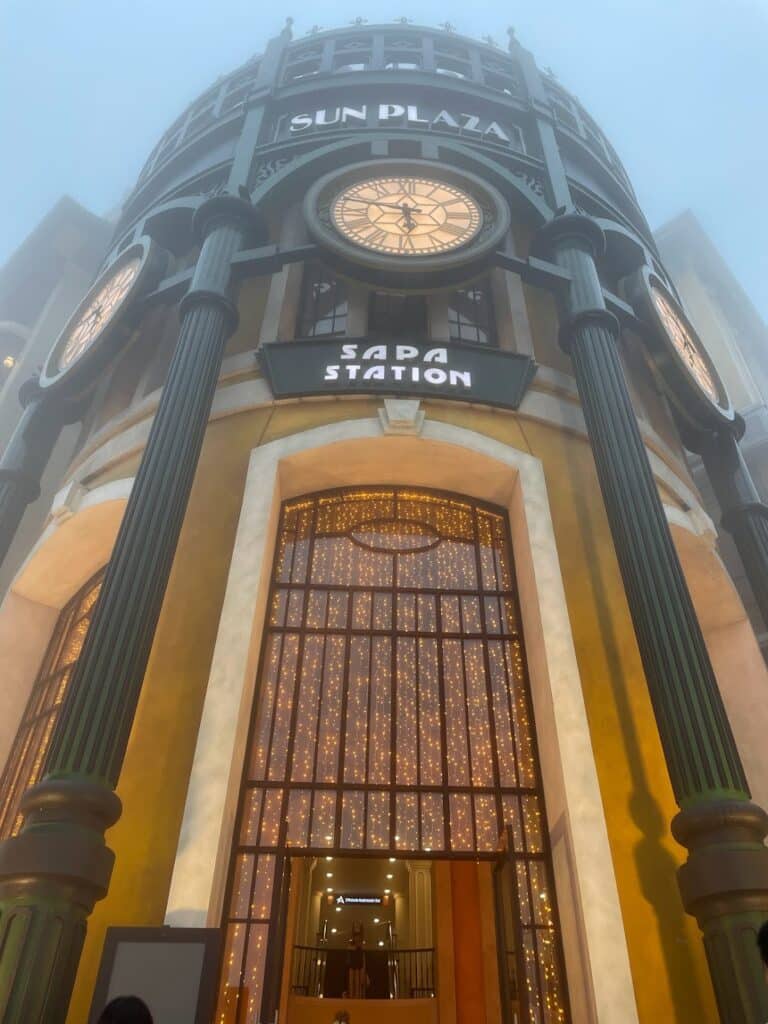

A few things you can do around Sapa town include:
- Walk around town and check out Sapa Lake and the flower garden
- Check out Sun Plaza, the larger shopping mall in Sapa
- Go to Instagram haven Moana Sapa and take all the photos you want (VND 80,000 entrance fee) but this is entirely set up for photo
- Get coffee from The Mist Sapa, a super chill cafe or Viettrekking Coffee & Restaurant, a cafe with an amazing view
- Grab ice cream from Mixue, a Chinese soft serve chain that is popular among locals. It’s not amazing or anything but I only saw locals here
Spend the evening getting some nice dinner and relax since you had a long day (and another long day tomorrow).
Day 2 in Sapa: Fansipan + Cat Cat Village
On your second and last day in Sapa you can explore two of its most famous attractions: the majestic Fansipan and the beautiful Cat Cat Village.
This itinerary assumes you have 2 full days in Sapa, meaning you are either spending the 2nd night in Sapa or taking an overnight bus or train back to Hanoi.
Fansipan
<Fansipan funicular and cable car system is closed from January 8 to Feb 8, 2024>
Fansipan, often referred to as the “Roof of Indochina,” is the highest mountain in Vietnam with about 10312 feet (3143 meter) in elevation.

Sun World operates a cable car that takes you (almost) to the top of Fansipan (and yes, it’s the same Sun World that built the famous Golden Bridge and Ba Na Hills near Danang).
Before the cable car was built, you would have to trek all the way up Fansipan with an overnight trip. You can still trek up but obviously you won’t have time to do that if you only have 2 days in Sapa.
From the Sun Plaza in Sapa town center, you can board a monorail to Muong Hoa Station. From there you will walk a bit to Hoang Lien Station and switch to the famous cable car to take you up to Fansipan.


The cable car ride takes about 20 minutes and as you go up you will see a nice view of Muong Hoa Valley and the entire Hoang Lien Son mountain range. After the cable car you can take a funicular up to near the peak. You just need to walk up a bit more stairs to the summit. Alternatively you can just walk up the steep steps instead of taking the funicular if you are looking for a challenge.
You can book your tickets ahead here or wait in line to buy in person at Sun Plaza.
The entire experience at Fansipan can take 3-4 hours so I suggest you go first thing in the morning when they open to maximize your day.
Unfortunately when we were in Sapa it was so foggy we were told at the ticket counter we wouldn’t be able to see anything, so we didn’t actually end up going. If I ever go back to Sapa again this would be on the top of my list.
Cat Cat Village
After getting back from Fansipan, you can walk about 20 minutes from Sapa town to Cat Cat Village, a super popular village that is pretty much made for Instagram.
Many will argue that Cat Cat Village is overly touristy and not authentic and I do not disagree. But I actually enjoyed Cat Cat Village quite a lot since it’s not something I have seen anywhere else.
You do not need a tour to visit Cat Cat Village as you can simply follow Google Maps and walk there yourself. On a clear day you can get a really nice view of the rice terraces as you walk down to Cat Cat Village (spoiler alert: we saw nothing because it was foggy).
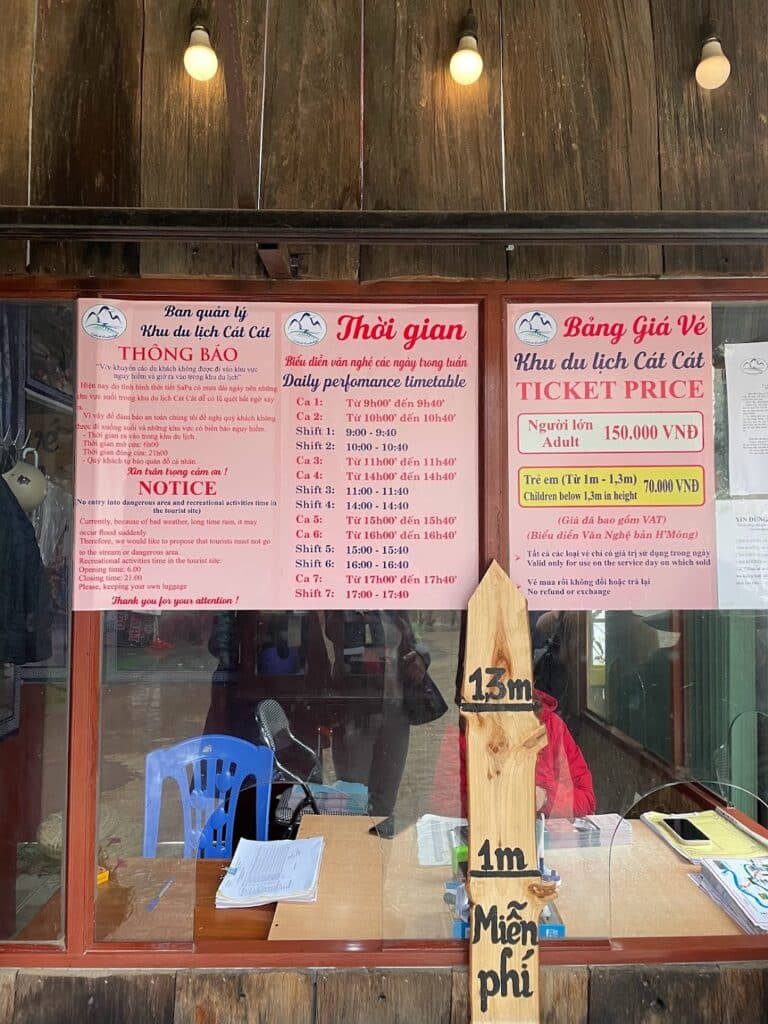

You need to purchase a ticket to enter Cat Cat Village. You will also see many traditional clothing rental shops outside of the entrance and I suggest you rent the clothes as it is pretty fun to dress up and take photos (domestic Vietnamese tourists definitely do this too).
Inside Cat Cat Village you will find photo spots, traditional houses, flower gardens, shops, suspension bridges, a small bamboo forest before reaching the famous Cat Cat Waterfall. There are performances near the waterfall as well, making it an entertaining half day trip from Sapa.
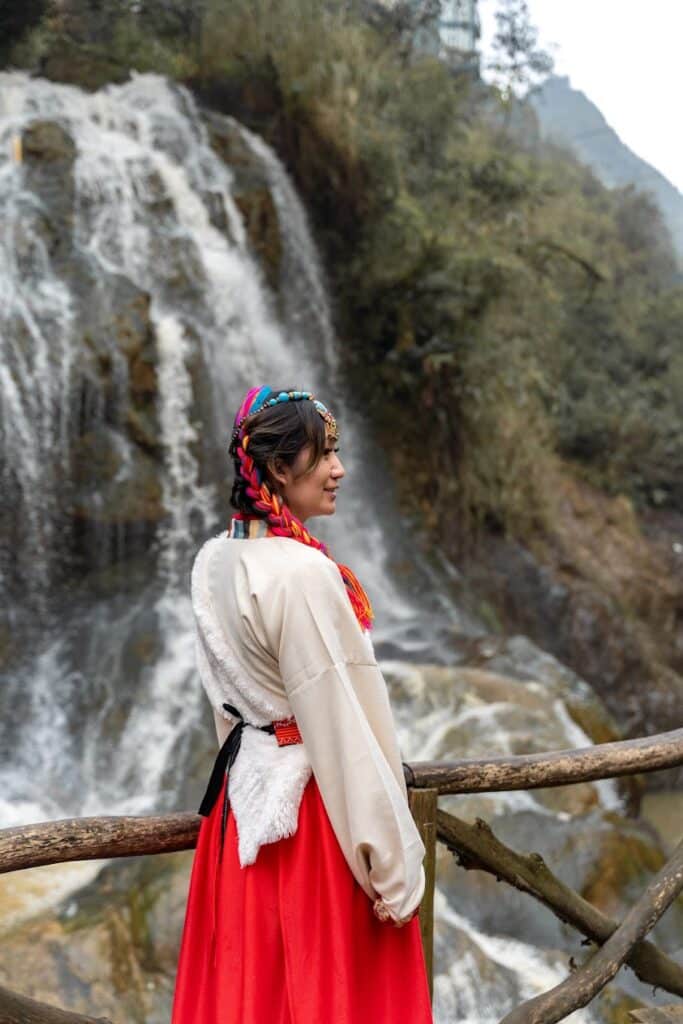

Even though Cat Cat Village can be quite touristy, I actually quite enjoyed it. A bonus is that it is at a lower elevation than Sapa, so you have a better chance of seeing the rice terraces here than from Sapa town.
After you are finished with Cat Cat Village in the afternoon, walk back (or take a taxi) to your hotel in Sapa and get ready to take your bus or train back to Hanoi.
Read Next: Detailed Guide on What to Do and See in Cat Cat Village
Other Unique Things to do in Sapa
If you are not looking to do a day trek or visit Cat Cat Village, don’t worry, there are still plenty of things you can do in Sapa.
Glass Bottom Bridge & Adventurous Activities
If you are scared of heights this one may be too thrilling for you. This 200 feet (60 meter) long glass bottom bridge is hanging 6561 feet (2000 meter) above ground and lets you have that panorama view of the surrounding mountains.
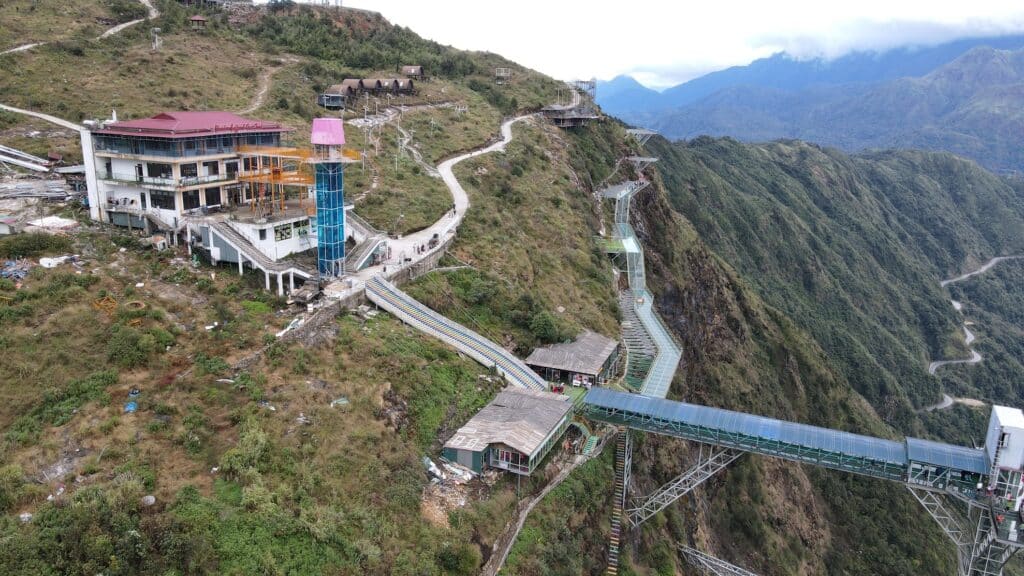
You can buy the ticket online and take the glass elevator up to the bridge. You have to wear a shoe cover on the bridge to protect the glass.
Besides the glass bridge, there is zip lining, bungee jumping, paragliding and other adventurous activities at the Glass Bridge in Sapa.
Love Waterfall and Silver Waterfall
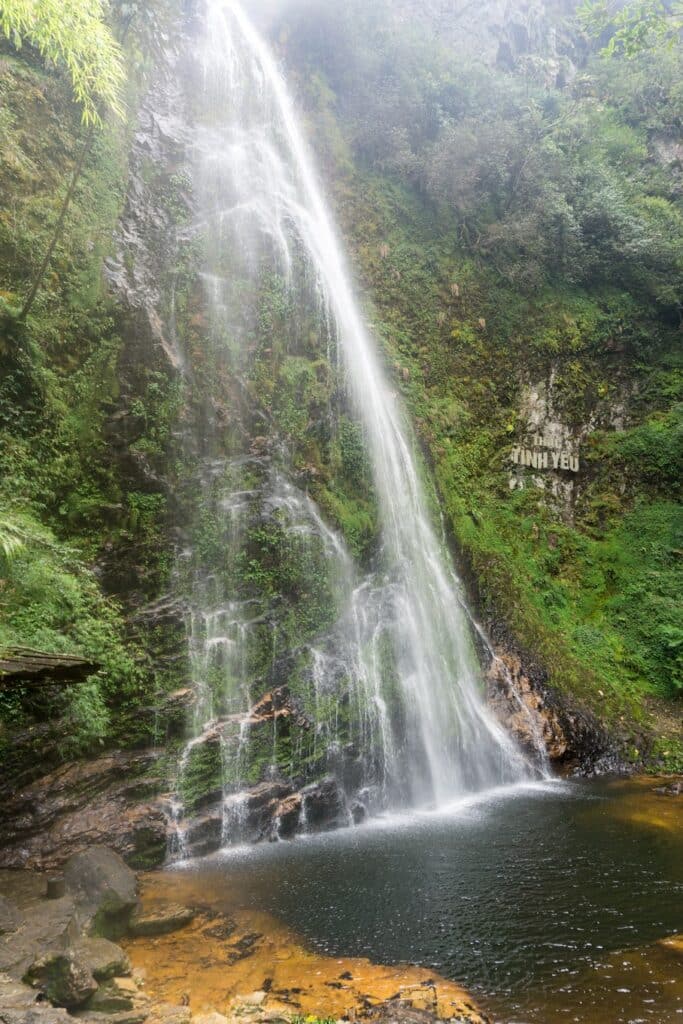

The most popular natural attraction in Sapa (besides Fansipan) is the Love Waterfall (Thac Tinh Yeu) and Silver Waterfall (Thac Bac). Both are not too far away from each other and you can easily reach by taxi or riding a motorcycle yourself.
If you don’t feel comfortable going alone, you can book a private day tour to see both waterfalls.
Hoang Lien National Park
If you want to see Fansipan and do some hiking in Hoang Lien National Park, then I highly recommend that you take a tour to Fansipan and see other photo spots along the way.
This is perfect if you care more about nature and rather spend all day exploring the national park instead of going to Cat Cat Village.
Hunt for Photos in Sapa
There are a number of photo spots in Sapa that are pretty much made for Instagram. I mentioned a couple of them for afternoon activities on the first day of your Sapa itinerary but there are way more!
In general you will need a taxi or to ride a motorbike yourself to these photo points (some are closer so you may be able to walk). You need to pay a small entrance fee to get in. Once inside, there are a ton of man-made photo opportunities, from pianos with mountain backdrops to Bali-like gates to swings to other photo spots.
Some of the best photo spots near Sapa include:
- Đỉnh đèo Ô Quy Hồ
- Lonely Tree (Cây cô đơn Sapa)
- Diem san may sapa
- Ansapa Village (has a fake Eiffel Tower)
- Moana Sapa
- Sapa Green Valley
You can search for photos of these on Google Map to see which one looks the best to you.
Explore caves near Sapa
Looking for a bit of an adventure? Don’t miss out on the caves near Sapa.
Two of the most popular caves for tourists include Ta Phin Cave and Động Tiên Sơn.
You will meet locals outside of Ta Phin Cave who will offer to take you in. They will give you a guided tour with light inside, otherwise you could potentially get lost inside the caves. You can explore Động Tiên Sơn by yourself after paying VND 20,000 entrance fee.
See an Old French Church (Tu Viện Cổ Tả Phìn)
If you are going to visit Ta Phin Cave, you can stop by the ruins of an old french church. Although abandoned, there will be street vendors there trying to sell you things. Otherwise the ruin is free to visit and make for some nice photos.
As you can see, there are a ton of things to do in Sapa outside of the famous Fansipan and Cat Cat Village. Although you cannot do everything mentioned above in 2 days, I hope this gives you some ideas on how you want to create a Sapa itinerary.
Bac Ha Market
If you have A LOT of time in Sapa, you can go to Bac Ha Market, located about 2.5 hours from Sapa town. This large market is only open on Sunday from morning to about 2pm in the afternoon.
In Bac Ha Market you will find a ton of ethnic minority costumes, trinkets, bags, and fresh produce and food there. You will find meat products from all sorts of animals, horses, pigs, chickens, etc.
How to Get Around Sapa
Sapa is a large area and not just a town. While most people stay in Sapa town, most of the activities I mentioned above are actually outside of Sapa Town.
Ultimately how you get around Sapa really depends on what you plan to do.
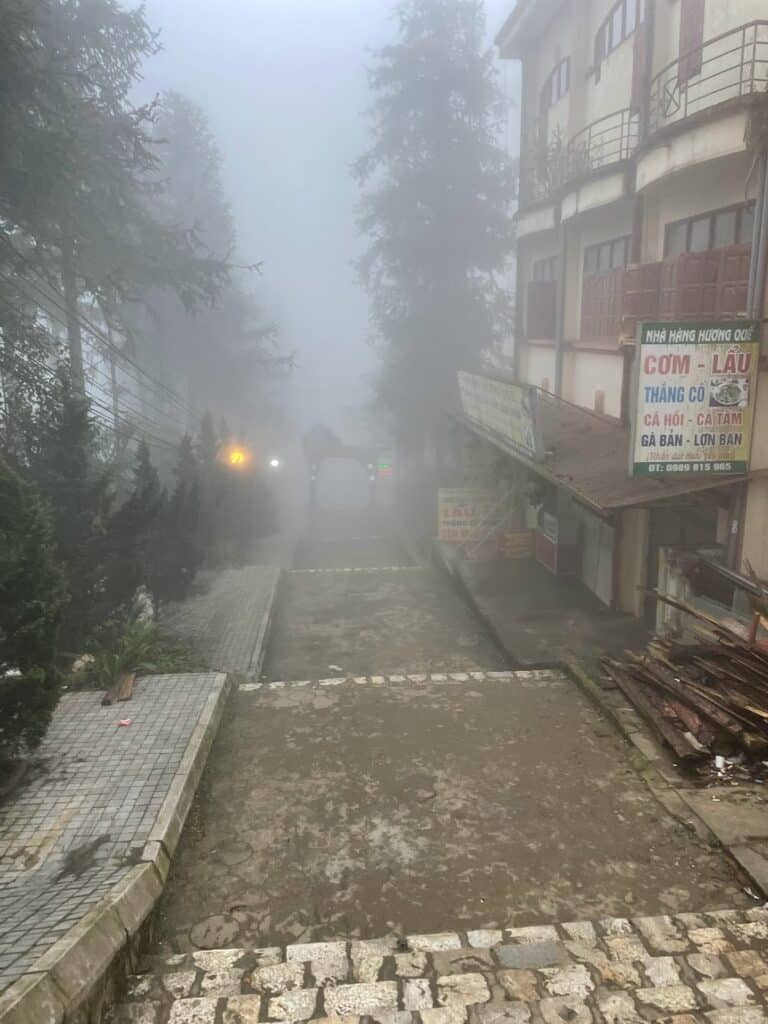

Walking around Sapa is the best for someone who wants to stay in Sapa town, or visit Fansipan and Cat Cat Village. Cat Cat Village is easily walkable from Sapa town (no guide needed) and Fansipan can be reached either by tour or by monorail and cable car.
If you plan to explore the waterfalls and glass bridge as well as some of the photo spots in Sapa I mentioned above, the cheapest way is to rent a scooter and bike there yourself. I would only suggest this if you feel comfortable riding a motorcycle and you should definitely consider getting travel insurance in case of injuries.
If you are like me and don’t want to ride a scooter, then the only way to reach further away places in Sapa is to take a taxi. Your hotel can generally help you arrange a private taxi to drive you around (and wait for you) for the day. We took a taxi back from Cat Cat Village because we were short on time (and we got lazy since it was going uphill back to Sapa town).
If you plan to get around Sapa by yourself, you should definitely get data on your phone. If you don’t, consider getting an eSim card and downloading Google offline Map!
Where to Eat in Sapa
There are a number of popular restaurants and cafes in Sapa. Here are some of the ones we tried:
24 Restaurant: Located really close to the Sapa Sisters’ office, this restaurant offers different kinds of Vietnamese food. We ordered Pho, fried rice and pancakes and all the food was pretty good. We actually went back there twice since we quite liked the restaurant.
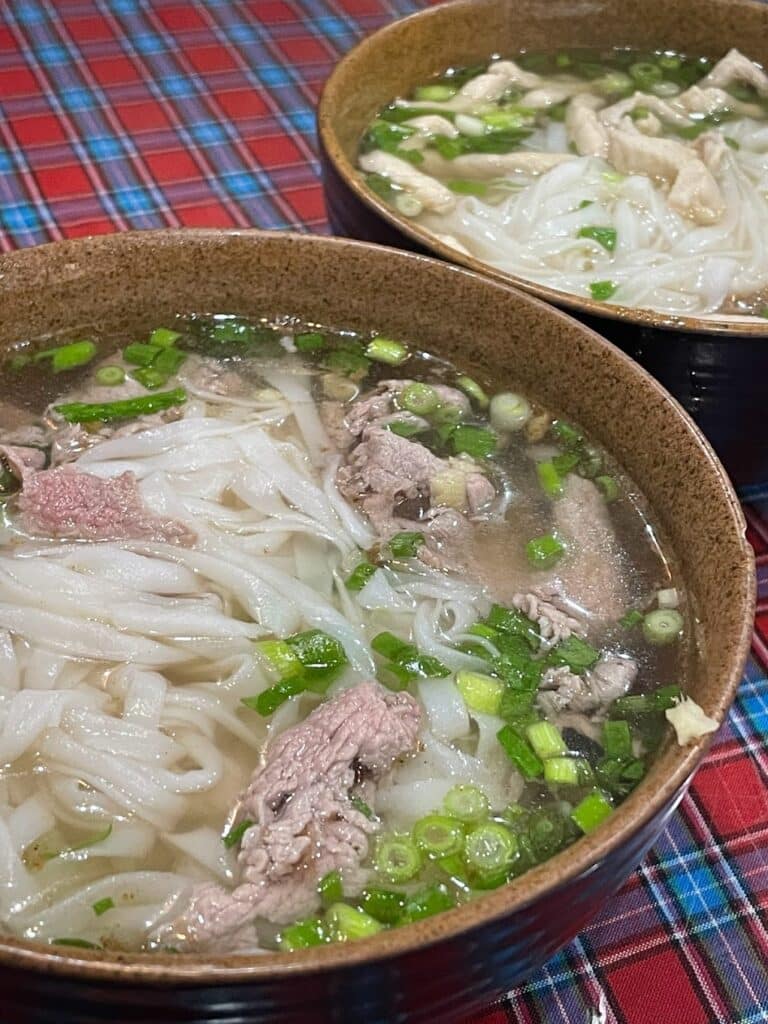
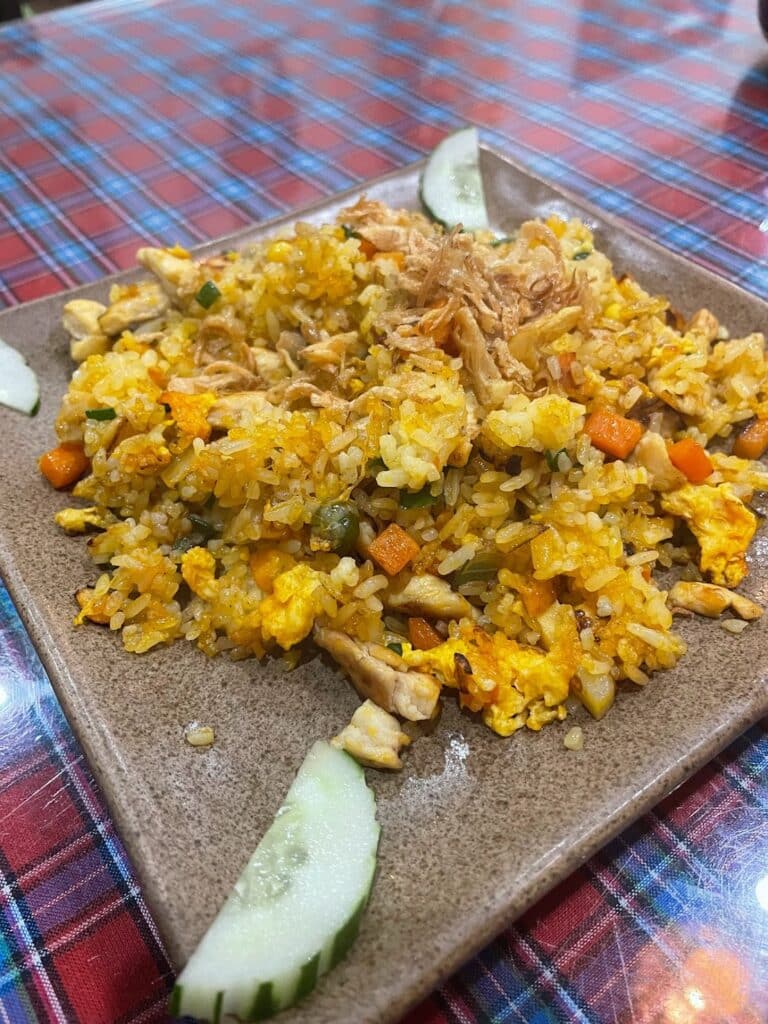
Chicago Pizza: You may wonder why we would go get pizza in Sapa. For one this was our last day after 10 days in Vietnam so we really wanted some western food. The restaurant is also highly rated with over 1000 reviews on Google so we gave it a try. We had a combination of pizza, fries and spring rolls (weird combo I know) but it was actually pretty tasty!
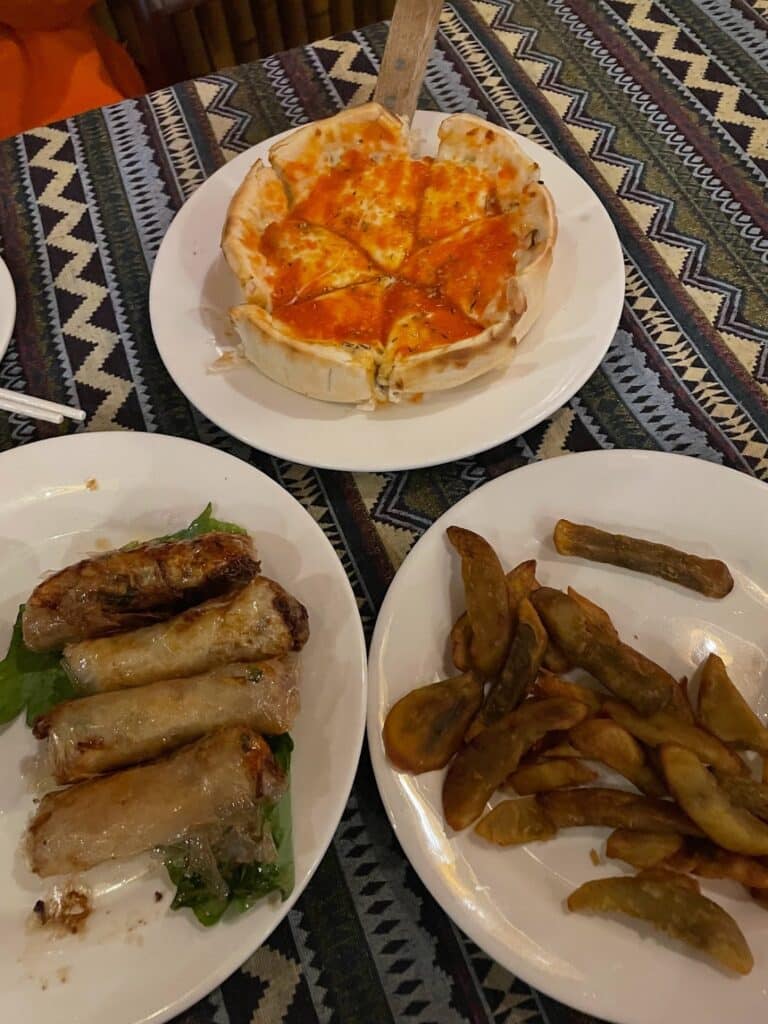
Mixue: It’s a local ice cream and bubble tea spot that originally came from China. I’ve only seen locals (especially young adults) there but I thought the soft serve and bubble tea were both not bad (and it is cheap since it’s not catered to tourists).
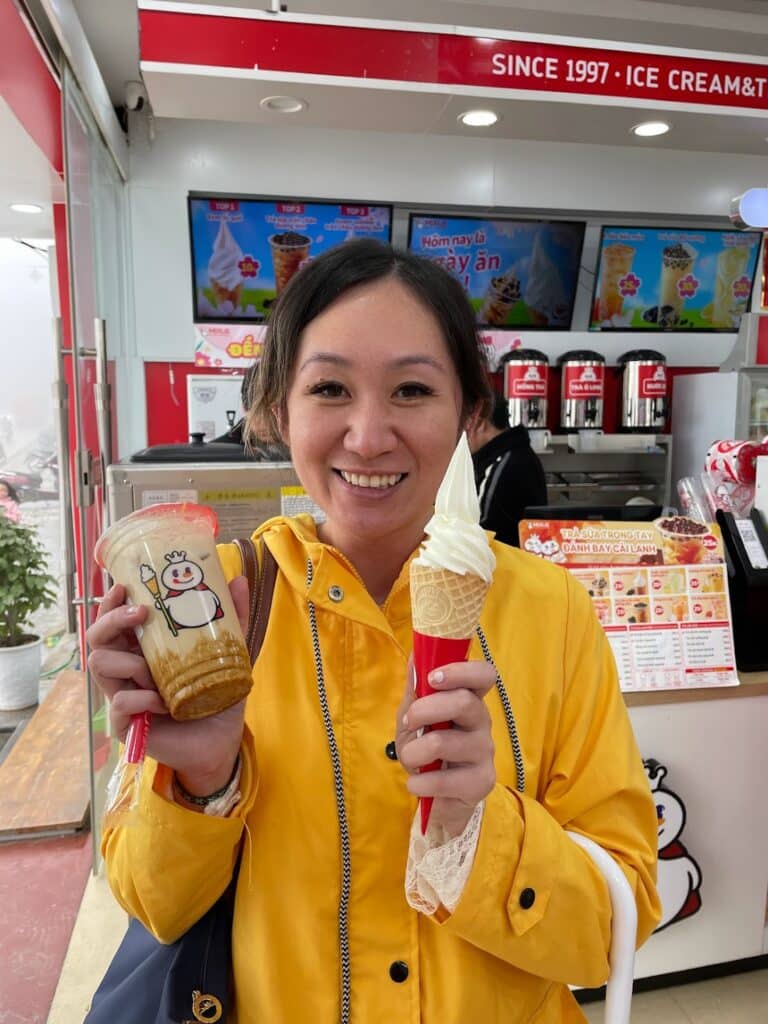
Hotpot Center: located not too far from Mixue near Sapa Lake is Hotpot Center. It is a large restaurant with terrace seating with a view of the square and the streets. This place is quite local as the menu is only in Vietnamese and servers speak limited English, but if you want hot pot this is the place you should try.
A Phủ Restaurant: one of the most popular restaurant in Sapa. It’s another hotpot spot with only a Vietnamese menu. Most people order either the salmon hotpot or the fish hotpot but you will find other Vietnamese food on the menu.
Cộng Cafe: If you are looking for coffee then you should definitely check out Cộng Cafe. This two story cafe is popular among locals (and some tourists). There is wifi and charging stations. Coconut coffee is one of the most popular items on the menu.
Packing List for Sapa
Here is my suggested packing list for Sapa so you arrive prepared especially if you plan to do trekking in Sapa.
- Jackets and layers: If you are visiting Sapa in the winter months, the place can be quite cold at night, so be sure to bring a thick jacket and layers. If you are going up to Fansipan then layers are a must as well.
- Raincoat: Sapa rains a lot, so you should always be prepared for rain especially if you are going to trek to the villages. A good rain jacket or shell can keep you dry during trekking.
- Hiking shoes or rain boots: If you are planning to trek then you really need good shoes. The ground can be really muddy so you should have either waterproof hiking shoes or rain boots. I only suggest rain boots because all the Hmong ladies that trekked with us wore rain boots and they did not slip once.
- Battery Pack: if you are going to be out all day or you are doing overnight trekking, you should definitely have battery pack with you to charge your phone.
- Disposable Bed Cover/ Pillow Case: If you are doing a sleeper train to Sapa like I did, I recommend these disposable one time use duet cover and pillow case. I don’t know how clean the sheets are on the train so I wanted to be safe and clean and these worked great.
- Toiletry: Don’t forget your toiletry. Depending on the hotel, some hotels may give you some toiletry whereas others do not. I did not see any super markets in Sapa when I was there so you should bring your own instead of trying to buy there.
- Extra pair of shoes: You can safely assume your hiking shoes will be gross and dirty. Always bring another pair of shoes to change to after you finish trekking.
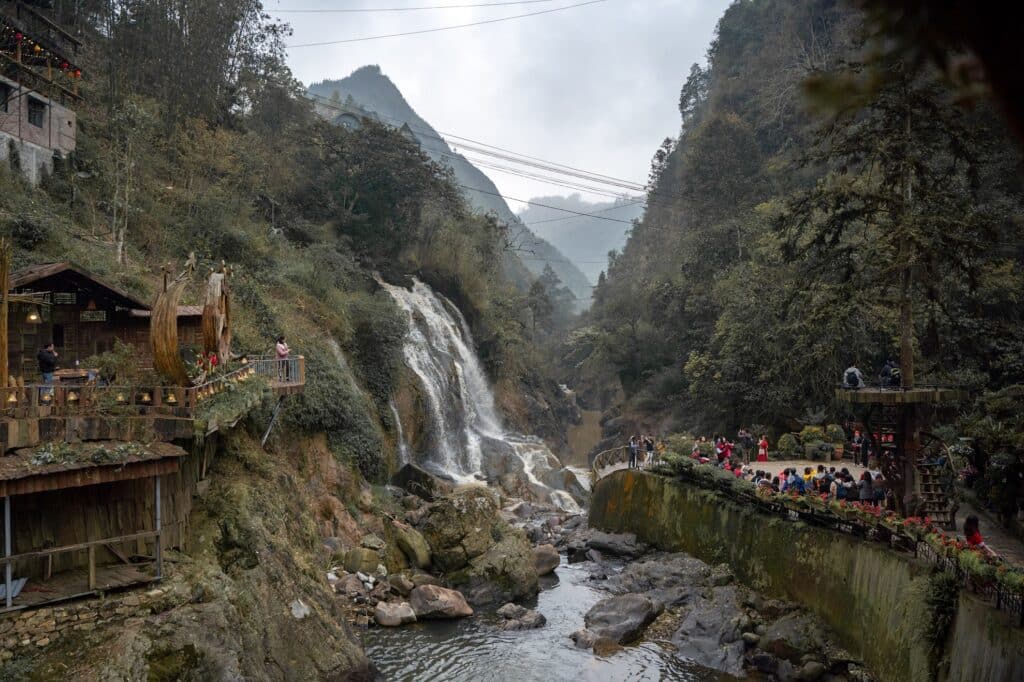
Is Sapa worth it or is it a tourist trap?
Sapa is worth seeing at least once. Yes, Sapa is touristy and it can be more expensive than other parts of Vietnam but the nature is truly breathtaking. From the rice terraces to Fansipan to the waterfalls, Sapa is an amazing place to visit to enjoy nature.
My only advice is to try to go in September so you can get better visibility and actually see the rice fields when they are the prettiest.
Alternatives to Sapa
If you want to see the rice terraces without the tourists, then there are a few alternatives you can do instead of Sapa.
Ha Giang is another beautiful region in Northern Vietnam, known for its amazing landscape and rice terrace. It is famous for the Ha Giant Loop, a 4 day road trip by motorcycle to see the glory of Ha Giang.
Mu Cang Chai: Mu Cang Chai is another beautiful Northern Vietnam region known for its stunning landscape and rice fields. It is actually not too far from Sapa and has trekking and sightseeing without the tourists. The place feels more authentic but you won’t find many hotels there as a trade off.
Other Vietnam Travel Articles
Below are some of my other Vietnam travel articles to help you plan your perfect Vietnam trip.
- 10 Day Vietnam Itinerary for First Time Visitors
- What to do and see in Cat Cat Village
- Is Halong Bay Cruise Worth It?
- How to Visit the Golden Bridge at Ba Na Hills in Danang
- 1 Day Hoi An Itinerary and Travel Guide
- How to Spend 2 Days in Hue
- How to get Vietnam eVisa
- Vietnam Sleeper Train: All You Need to Know to Survive
- Vietnam and Thailand 3 Week Itinerary
Like this post? Pin this 2 day Sapa itinerary to Pinterest!

